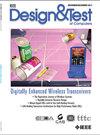EDA meets biology! The bumpy road ahead [Perscetives]
引用次数: 0
Abstract
Before the 1970s, design automation was used more intensely in mechanical and civil engineering. In the 1970s, it became clear that the design of electrical and electronic circuits could be greatly aided by software tools. These tools enabled the creation of a novel electronic design automation (EDA) industry that claimed its space in the software industry. Today there is not a single IC company that does not use EDA tools. But because of this fact, EDA's overall market is saturated and enjoys modest growth. Much has been talked about extending EDA in the system space. To the rescue of a difficult path to double digit growth in EDA comes Synthetic Biology! Synthetic biology is about the synthesis of complex biological systems to obtain behaviors that do not exist in nature. A METHODOLOGY HAS come to the rescue within the past decade to reduce complexity, and to provide abstraction and design composability. The methodology is based on the availability of biological primitives: DNA-encoded 'Parts' are designed and then assembled to create modular 'Devices' that can be integrated into a host organism or assembled into a larger 'System.' This process resembles very much what we do today with integrated circuits. This methodology has enabled the development of design tools and a new discipline has emerged: Biology Design Automation (BDA). Workshops related to biodesign automation are appearing at traditional EDA venues (DAC), bioinformatics conferences (ISMB), and synthetic biology meetings (SB X.0). The way for EDA to extend to a new exciting field through the systematic construction of biological circuits maybe bumpy with detours, but eventually will enable the creation of a new industry by providing tools that make the design of living systems a true engineering discipline which is safe and effective.EDA遇上生物学!前路坎坷[观点]
在20世纪70年代之前,设计自动化在机械和土木工程中得到了更广泛的应用。20世纪70年代,人们逐渐认识到,电子电路的设计可以借助软件工具得到极大的帮助。这些工具促成了在软件行业中占有一席之地的新型电子设计自动化(EDA)行业的创建。今天,没有一家IC公司不使用EDA工具。但由于这一事实,EDA的整体市场已经饱和,并享有适度的增长。关于在系统空间中扩展EDA已经讨论了很多。为了挽救EDA实现两位数增长的艰难道路,合成生物学来了!合成生物学是关于复杂生物系统的合成,以获得自然界中不存在的行为。在过去的十年里,一种方法开始拯救我们,以减少复杂性,并提供抽象和设计的可组合性。该方法基于生物原语的可用性:设计dna编码的“部件”,然后组装以创建模块化的“设备”,这些“设备”可以集成到宿主生物体中或组装成更大的“系统”。这个过程与我们今天用集成电路所做的非常相似。这种方法使设计工具的发展和一个新的学科已经出现:生物设计自动化(BDA)。与生物设计自动化相关的研讨会出现在传统的EDA会场(DAC)、生物信息学会议(ISMB)和合成生物学会议(sbx .0)上。EDA通过生物电路的系统构建扩展到一个令人兴奋的新领域的道路可能会有曲折,但最终将通过提供使生命系统设计成为真正安全有效的工程学科的工具来创造一个新的行业。
本文章由计算机程序翻译,如有差异,请以英文原文为准。
求助全文
约1分钟内获得全文
求助全文

 求助内容:
求助内容: 应助结果提醒方式:
应助结果提醒方式:


